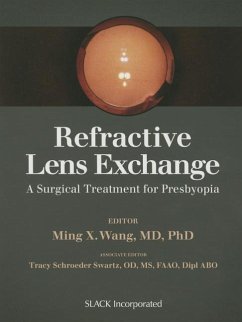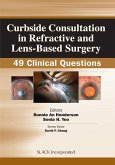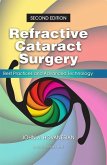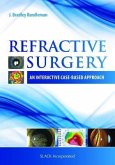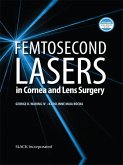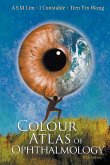- Gebundenes Buch
- Merkliste
- Auf die Merkliste
- Bewerten Bewerten
- Teilen
- Produkt teilen
- Produkterinnerung
- Produkterinnerung
Permanent surgical treatment for presbyopia remains the hereto unconquered "last frontier" in anterior segment surgery.
Andere Kunden interessierten sich auch für
![Curbside Consultation in Refractive and Lens-Based Surgery Curbside Consultation in Refractive and Lens-Based Surgery]() Curbside Consultation in Refractive and Lens-Based Surgery145,99 €
Curbside Consultation in Refractive and Lens-Based Surgery145,99 €![Refractive Cataract Surgery Refractive Cataract Surgery]() John HovanesianRefractive Cataract Surgery207,99 €
John HovanesianRefractive Cataract Surgery207,99 €![Refractive Surgery Refractive Surgery]() J. Bradley RandlemanRefractive Surgery183,99 €
J. Bradley RandlemanRefractive Surgery183,99 €![Femtosecond Lasers in Cornea and Lens Surgery Femtosecond Lasers in Cornea and Lens Surgery]() George WaringFemtosecond Lasers in Cornea and Lens Surgery279,99 €
George WaringFemtosecond Lasers in Cornea and Lens Surgery279,99 €![Cancer through the Lens of Evolution and Ecology Cancer through the Lens of Evolution and Ecology]() Cancer through the Lens of Evolution and Ecology192,99 €
Cancer through the Lens of Evolution and Ecology192,99 €![Cataract and Refractive Surgery Cataract and Refractive Surgery]() Thomas Kohnen / Douglas D. KochCataract and Refractive Surgery127,99 €
Thomas Kohnen / Douglas D. KochCataract and Refractive Surgery127,99 €![COLOUR ATLAS OPHTHALM (5TH ED) COLOUR ATLAS OPHTHALM (5TH ED)]() Ian Constable Et Al Arthur Sm LimCOLOUR ATLAS OPHTHALM (5TH ED)45,99 €
Ian Constable Et Al Arthur Sm LimCOLOUR ATLAS OPHTHALM (5TH ED)45,99 €-
-
-
Permanent surgical treatment for presbyopia remains the hereto unconquered "last frontier" in anterior segment surgery.
Hinweis: Dieser Artikel kann nur an eine deutsche Lieferadresse ausgeliefert werden.
Hinweis: Dieser Artikel kann nur an eine deutsche Lieferadresse ausgeliefert werden.
Produktdetails
- Produktdetails
- Verlag: CRC Press
- Seitenzahl: 180
- Erscheinungstermin: 15. Oktober 2015
- Englisch
- Abmessung: 286mm x 221mm x 14mm
- Gewicht: 728g
- ISBN-13: 9781630910716
- ISBN-10: 1630910716
- Artikelnr.: 42561617
- Herstellerkennzeichnung
- Libri GmbH
- Europaallee 1
- 36244 Bad Hersfeld
- gpsr@libri.de
- Verlag: CRC Press
- Seitenzahl: 180
- Erscheinungstermin: 15. Oktober 2015
- Englisch
- Abmessung: 286mm x 221mm x 14mm
- Gewicht: 728g
- ISBN-13: 9781630910716
- ISBN-10: 1630910716
- Artikelnr.: 42561617
- Herstellerkennzeichnung
- Libri GmbH
- Europaallee 1
- 36244 Bad Hersfeld
- gpsr@libri.de
Ming Wang, MD, PhD, is the Director of Wang Vision Cataract and LASIK Center in Nashville, TN, Clinical Associate Professor of the University of Tennessee, and International President of Shanghai Aier Eye Hospital. Dr. Wang graduated from Harvard Medical School and Massachusetts Institute of Technology (MD, magna cum laude) in Boston, Massachusetts; holds a doctorate degree in laser spectroscopy; and completed his residency at Wills Eye Hospital in Philadelphia, Pennsylvania, and his corneal and refractive surgery fellowship at Bascom Palmer Eye Institute, Miami, Florida. He is an editorial board member of Cataract and Refractive Surgery Today and Refractive Eye Care. A former panel consultant to the United States Food and Drug Administration Ophthalmic Device Panel and a founding director of Vanderbilt Laser Sight Center, Dr. Wang published a paper in the world-renowned journal, Nature. This was followed by his editing of 6 ophthalmic textbooks: Corneal Topography in the Wavefront Era (SLACK Incorporated, 2005), Irregular Astigmatism: Diagnosis and Treatment (SLACK Incorporated, 2006), Corneal Dystrophy and Degeneration: A Molecular Genetic Approach (American Academy of Ophthalmology, 2003), Keratoconus and Keratoectasia: Prevention, Diagnosis and Treatment (SLACK Incorporated, 2009), Corneal Topography in the Wavefront Era, Second Edition (SLACK Incorporated, 2010), and Atlas and Clinical Guide to Corneal Topography (SLACK Incorporated, 2013). Additionally, he has published over 120 papers and book chapters. Dr. Wang has several United States patents for his inventions of new biotechnologies to restore sight, including an amniotic membrane contact lens, an adaptive infrared retinoscopic device for detecting ocular aberrations, and a digital eye bank for virtual clinical trials. His invention of amniotic membrane contact lens has been used by over 1000 surgeons in the United States in treating ocular surface diseases to restore sight. Dr. Wang is an investigator in the Food and Drug Administration clinical trial of sclera-spacing procedure to treat age-related loss of near vision (presbyopia) and UV cross-linking for the treatment of keratoconus. He introduced the femtosecond laser to China, and performed China's first LASIK procedure using this laser in 2005. He also performed the world's first femtosecond laser-assisted artificial cornea implantation (Alphacor), and the first Intacs (Addition Technologies, Inc) procedure in the United States using a new version of Intacs for keratoconus. Dr. Wang was a recipient of the Academy of Ophthalmology Honor Award, as well as the Lifetime Achievement Award of the Association of Chinese American Physicians. As the founding president of the Tennessee Chinese Chamber of Commerce, co-founder of the Tennessee Immigrant and Minority Group, and co-owner and international president of Shanghai Aier Eye Hospitals in Shanghai, China, which is the largest private eye hospital group in China today with 71 locations, Dr. Wang founded a 501c(3) nonprofit organization called the Wang Foundation for Christian Outreach to China. Dr. Wang specializes in LASIK, laser refractive lens exchange for the treatment of presbyopia, laser refractive cataract surgery, corneal and external diseases including keratoconus, and ocular surface disease treatment using amniotic membrane contact lens. He runs a busy international referral clinic for post-LASIK and post-cataract surgery complications. He founded another 501c(3) nonprofit charity, the Wang Foundation for Sight Restoration, which has also helped patients from over 40 states in the United States and 55 countries worldwide, with all sight restoration surgeries performed free of charge. Dr. Wang is a champion amateur ballroom dancer and a former finalist in the world ballroom dance championships in the open pro-am international 10 dance. He plays the Chinese violin (er-hu) and accompanied country music legend, Dolly Parton, on her CD entitled Those Were the Days. Dr. Wang organized an annual classical ballroom dance sight charity event, the EyeBall, which is now in its 10th year, and has drawn attendees from all over the United States and around the world. Tracy Schroeder Swartz, OD, MS, FAAO, currently practices optometry, specializing in anterior segment disease, in Madison, Alabama. Originally from Wisconsin, Dr. Schroeder Swartz attended Indiana University for her undergraduate education. During optometry school, she served as an assistant instructor for the biology department and became interested in pediatrics and strabismus. After completing her doctorate, Dr. Schroeder Swartz pursued a master's degree in physiological optics, specializing in pediatrics. She served as faculty at the Indiana University School of Optometry for 4 years, and earned the Indiana Chapter of the American Academy of Optometry Gordon Heath Fellowship in 1996. After completion of her master's degree, Dr. Schroeder Swartz relocated to Washington, DC, where she specialized in refractive and corneal surgery, and earned her Fellowship in the American Academy of Optometry. She later joined Wang Vision Institute in Nashville, where she served as Director of Clinical Operations, Residency Director for the Optometric Residency Program, and adjunct faculty to Indiana University School of Optometry. While there, she edited 2 textbooks with Ming Wang, MD, PhD: Corneal Topography in the Wavefront Era (SLACK Incorporated, 2006) and Irregular Astigmatism: Diagnosis and Treatment (SLACK Incorporated, 2007), as well as authoring numerous book chapters on refractive surgery, topography, aberrometry, and anterior segment disease. She served as coeditor for the literature review column for Cataract and Refractive Surgery Today from 2003 to 2008, as well as serving on the editorial board for Optometry Times . She left Nashville for Huntsville, Alabama where she became the Center Director for VisionAmerica. She edited two textbooks-Keratoconus and Keratoectasia: Prevention, Diagnosis and Treatment (SLACK Incorporated, 2009) and The Corneal Handbook (SLACK Incorporated, 2010)-followed by Topography in the Wavefront Era, Second Edition (SLACK Incorporated, 2011). She is a board member of the Optometric Council for Refractive Technology, and serves as the Education Chair for the organization.
Dedication Acknowledgments About the Editors Contributing Authors Preface Foreword by Richard L. Lindstrom
MD Chapter 1 Overview of Current Surgical Treatment for PresbyopiaBarrie Soloway
MD Chapter 2 Biomechanics of Accommodation and Presbyopia: Dysfunctional Lens SyndromeDaniel B. Goldberg
MD
FACS; Jern Yee Chen
FRANZCO
MMed; and George O. Waring IV
MD
FACS Chapter 3 Patient Education Issues in the Emerging Refractive Lens Exchange MarketJohn B. Pinto Chapter 4 Preoperative Assessment for Refractive Lens ExchangeNeel R. Desai
MD Chapter 5 New Technologies in Anterior Segment Diagnostic Assessment for Refractive Lens ExchangeMichael J. Endl
MD; David W. Friess
OD
FAAO; Victor Arni D. P. Sicam
PhD; and Lance Kugler
MD Chapter 6 Retinal Issues Associated With Refractive Lens Exchange SurgeryJudah E. Beck
MD; Mujtaba A. Qazi
MD; Nancy M. Holekamp
MD; and Jay S. Pepose
MD
PhD Chapter 7 Presbyopic Intraocular Lens Implantation for Refractive Lens Exchange Using Multifocal Intraocular LensesNeel R. Desai
MD Chapter 8 Presbyopic Intraocular Lens Implantation for Refractive Lens Exchange Using an Accommodative Intraocular LensAnita Nevyas-Wallace
MD Chapter 9 Toric Intraocular Lenses for Refractive Lens ExchangeNeel R. Desai
MD Chapter 10 Corneal-Based Astigmatism Correction: Limbal Relaxing Incisions and Laser Astigmatic KeratotomyAnita Nevyas-Wallace
MD; Cynthia J. Roberts
PhD; Robert Weinstock
MD; Neel R. Desai
MD Chapter 11 Calculating Intraocular Lens PowerIlan Cohen
MD Chapter 12 Intraoperative AberrometryTracy Schroeder Swartz
OD
MS
FAAO; Marwah Shahid
BA; and Ming Wang
MD
PhD Chapter 13 High-Definition Three-Dimensional Microsurgical Visualization and Positioning TechnologyDavid W. Friess
OD
FAAO and William Trattler
MD Chapter 14 Femtosecond Laser in Refractive Lens ExchangeArun C. Gulani
MD
MS Chapter 15 Postoperative ConsiderationsJay Bansal
MD Chapter 16 Postoperative Adverse EventsIlan Cohen
MD and Jay Bansal
MD Chapter 17 Yttrium Aluminum Garnet Capsulotomy After Premium Intraocular Lenses: Indications and AlternativesLisa Martén
MD
MPH Chapter 18 Keratorefractive Enhancement After Refractive Lens Exchange SurgeryKarl Stonecipher
MD and Alan Faulkner
MD Chapter 19 In-Office Surgery and Short-Interval
Bilateral Same-Day Surgery in Refractive Lens ExchangePaul Dougherty
MD and Ryan Vida
OD
FAAO Chapter 20 Marketing Refractive Lens Exchange as a Surgical Treatment for PresbyopiaVance Thompson
MD
FACSS; Shareef Mahdavi
BA; and Matt Jensen
MBA Chapter 21 Future of Refractive Lens ExchangeMarc Moore
MD and Ming Wang
MD
PhD Financial Disclosures Index
MD Chapter 1 Overview of Current Surgical Treatment for PresbyopiaBarrie Soloway
MD Chapter 2 Biomechanics of Accommodation and Presbyopia: Dysfunctional Lens SyndromeDaniel B. Goldberg
MD
FACS; Jern Yee Chen
FRANZCO
MMed; and George O. Waring IV
MD
FACS Chapter 3 Patient Education Issues in the Emerging Refractive Lens Exchange MarketJohn B. Pinto Chapter 4 Preoperative Assessment for Refractive Lens ExchangeNeel R. Desai
MD Chapter 5 New Technologies in Anterior Segment Diagnostic Assessment for Refractive Lens ExchangeMichael J. Endl
MD; David W. Friess
OD
FAAO; Victor Arni D. P. Sicam
PhD; and Lance Kugler
MD Chapter 6 Retinal Issues Associated With Refractive Lens Exchange SurgeryJudah E. Beck
MD; Mujtaba A. Qazi
MD; Nancy M. Holekamp
MD; and Jay S. Pepose
MD
PhD Chapter 7 Presbyopic Intraocular Lens Implantation for Refractive Lens Exchange Using Multifocal Intraocular LensesNeel R. Desai
MD Chapter 8 Presbyopic Intraocular Lens Implantation for Refractive Lens Exchange Using an Accommodative Intraocular LensAnita Nevyas-Wallace
MD Chapter 9 Toric Intraocular Lenses for Refractive Lens ExchangeNeel R. Desai
MD Chapter 10 Corneal-Based Astigmatism Correction: Limbal Relaxing Incisions and Laser Astigmatic KeratotomyAnita Nevyas-Wallace
MD; Cynthia J. Roberts
PhD; Robert Weinstock
MD; Neel R. Desai
MD Chapter 11 Calculating Intraocular Lens PowerIlan Cohen
MD Chapter 12 Intraoperative AberrometryTracy Schroeder Swartz
OD
MS
FAAO; Marwah Shahid
BA; and Ming Wang
MD
PhD Chapter 13 High-Definition Three-Dimensional Microsurgical Visualization and Positioning TechnologyDavid W. Friess
OD
FAAO and William Trattler
MD Chapter 14 Femtosecond Laser in Refractive Lens ExchangeArun C. Gulani
MD
MS Chapter 15 Postoperative ConsiderationsJay Bansal
MD Chapter 16 Postoperative Adverse EventsIlan Cohen
MD and Jay Bansal
MD Chapter 17 Yttrium Aluminum Garnet Capsulotomy After Premium Intraocular Lenses: Indications and AlternativesLisa Martén
MD
MPH Chapter 18 Keratorefractive Enhancement After Refractive Lens Exchange SurgeryKarl Stonecipher
MD and Alan Faulkner
MD Chapter 19 In-Office Surgery and Short-Interval
Bilateral Same-Day Surgery in Refractive Lens ExchangePaul Dougherty
MD and Ryan Vida
OD
FAAO Chapter 20 Marketing Refractive Lens Exchange as a Surgical Treatment for PresbyopiaVance Thompson
MD
FACSS; Shareef Mahdavi
BA; and Matt Jensen
MBA Chapter 21 Future of Refractive Lens ExchangeMarc Moore
MD and Ming Wang
MD
PhD Financial Disclosures Index
Dedication Acknowledgments About the Editors Contributing Authors Preface Foreword by Richard L. Lindstrom
MD Chapter 1 Overview of Current Surgical Treatment for PresbyopiaBarrie Soloway
MD Chapter 2 Biomechanics of Accommodation and Presbyopia: Dysfunctional Lens SyndromeDaniel B. Goldberg
MD
FACS; Jern Yee Chen
FRANZCO
MMed; and George O. Waring IV
MD
FACS Chapter 3 Patient Education Issues in the Emerging Refractive Lens Exchange MarketJohn B. Pinto Chapter 4 Preoperative Assessment for Refractive Lens ExchangeNeel R. Desai
MD Chapter 5 New Technologies in Anterior Segment Diagnostic Assessment for Refractive Lens ExchangeMichael J. Endl
MD; David W. Friess
OD
FAAO; Victor Arni D. P. Sicam
PhD; and Lance Kugler
MD Chapter 6 Retinal Issues Associated With Refractive Lens Exchange SurgeryJudah E. Beck
MD; Mujtaba A. Qazi
MD; Nancy M. Holekamp
MD; and Jay S. Pepose
MD
PhD Chapter 7 Presbyopic Intraocular Lens Implantation for Refractive Lens Exchange Using Multifocal Intraocular LensesNeel R. Desai
MD Chapter 8 Presbyopic Intraocular Lens Implantation for Refractive Lens Exchange Using an Accommodative Intraocular LensAnita Nevyas-Wallace
MD Chapter 9 Toric Intraocular Lenses for Refractive Lens ExchangeNeel R. Desai
MD Chapter 10 Corneal-Based Astigmatism Correction: Limbal Relaxing Incisions and Laser Astigmatic KeratotomyAnita Nevyas-Wallace
MD; Cynthia J. Roberts
PhD; Robert Weinstock
MD; Neel R. Desai
MD Chapter 11 Calculating Intraocular Lens PowerIlan Cohen
MD Chapter 12 Intraoperative AberrometryTracy Schroeder Swartz
OD
MS
FAAO; Marwah Shahid
BA; and Ming Wang
MD
PhD Chapter 13 High-Definition Three-Dimensional Microsurgical Visualization and Positioning TechnologyDavid W. Friess
OD
FAAO and William Trattler
MD Chapter 14 Femtosecond Laser in Refractive Lens ExchangeArun C. Gulani
MD
MS Chapter 15 Postoperative ConsiderationsJay Bansal
MD Chapter 16 Postoperative Adverse EventsIlan Cohen
MD and Jay Bansal
MD Chapter 17 Yttrium Aluminum Garnet Capsulotomy After Premium Intraocular Lenses: Indications and AlternativesLisa Martén
MD
MPH Chapter 18 Keratorefractive Enhancement After Refractive Lens Exchange SurgeryKarl Stonecipher
MD and Alan Faulkner
MD Chapter 19 In-Office Surgery and Short-Interval
Bilateral Same-Day Surgery in Refractive Lens ExchangePaul Dougherty
MD and Ryan Vida
OD
FAAO Chapter 20 Marketing Refractive Lens Exchange as a Surgical Treatment for PresbyopiaVance Thompson
MD
FACSS; Shareef Mahdavi
BA; and Matt Jensen
MBA Chapter 21 Future of Refractive Lens ExchangeMarc Moore
MD and Ming Wang
MD
PhD Financial Disclosures Index
MD Chapter 1 Overview of Current Surgical Treatment for PresbyopiaBarrie Soloway
MD Chapter 2 Biomechanics of Accommodation and Presbyopia: Dysfunctional Lens SyndromeDaniel B. Goldberg
MD
FACS; Jern Yee Chen
FRANZCO
MMed; and George O. Waring IV
MD
FACS Chapter 3 Patient Education Issues in the Emerging Refractive Lens Exchange MarketJohn B. Pinto Chapter 4 Preoperative Assessment for Refractive Lens ExchangeNeel R. Desai
MD Chapter 5 New Technologies in Anterior Segment Diagnostic Assessment for Refractive Lens ExchangeMichael J. Endl
MD; David W. Friess
OD
FAAO; Victor Arni D. P. Sicam
PhD; and Lance Kugler
MD Chapter 6 Retinal Issues Associated With Refractive Lens Exchange SurgeryJudah E. Beck
MD; Mujtaba A. Qazi
MD; Nancy M. Holekamp
MD; and Jay S. Pepose
MD
PhD Chapter 7 Presbyopic Intraocular Lens Implantation for Refractive Lens Exchange Using Multifocal Intraocular LensesNeel R. Desai
MD Chapter 8 Presbyopic Intraocular Lens Implantation for Refractive Lens Exchange Using an Accommodative Intraocular LensAnita Nevyas-Wallace
MD Chapter 9 Toric Intraocular Lenses for Refractive Lens ExchangeNeel R. Desai
MD Chapter 10 Corneal-Based Astigmatism Correction: Limbal Relaxing Incisions and Laser Astigmatic KeratotomyAnita Nevyas-Wallace
MD; Cynthia J. Roberts
PhD; Robert Weinstock
MD; Neel R. Desai
MD Chapter 11 Calculating Intraocular Lens PowerIlan Cohen
MD Chapter 12 Intraoperative AberrometryTracy Schroeder Swartz
OD
MS
FAAO; Marwah Shahid
BA; and Ming Wang
MD
PhD Chapter 13 High-Definition Three-Dimensional Microsurgical Visualization and Positioning TechnologyDavid W. Friess
OD
FAAO and William Trattler
MD Chapter 14 Femtosecond Laser in Refractive Lens ExchangeArun C. Gulani
MD
MS Chapter 15 Postoperative ConsiderationsJay Bansal
MD Chapter 16 Postoperative Adverse EventsIlan Cohen
MD and Jay Bansal
MD Chapter 17 Yttrium Aluminum Garnet Capsulotomy After Premium Intraocular Lenses: Indications and AlternativesLisa Martén
MD
MPH Chapter 18 Keratorefractive Enhancement After Refractive Lens Exchange SurgeryKarl Stonecipher
MD and Alan Faulkner
MD Chapter 19 In-Office Surgery and Short-Interval
Bilateral Same-Day Surgery in Refractive Lens ExchangePaul Dougherty
MD and Ryan Vida
OD
FAAO Chapter 20 Marketing Refractive Lens Exchange as a Surgical Treatment for PresbyopiaVance Thompson
MD
FACSS; Shareef Mahdavi
BA; and Matt Jensen
MBA Chapter 21 Future of Refractive Lens ExchangeMarc Moore
MD and Ming Wang
MD
PhD Financial Disclosures Index

